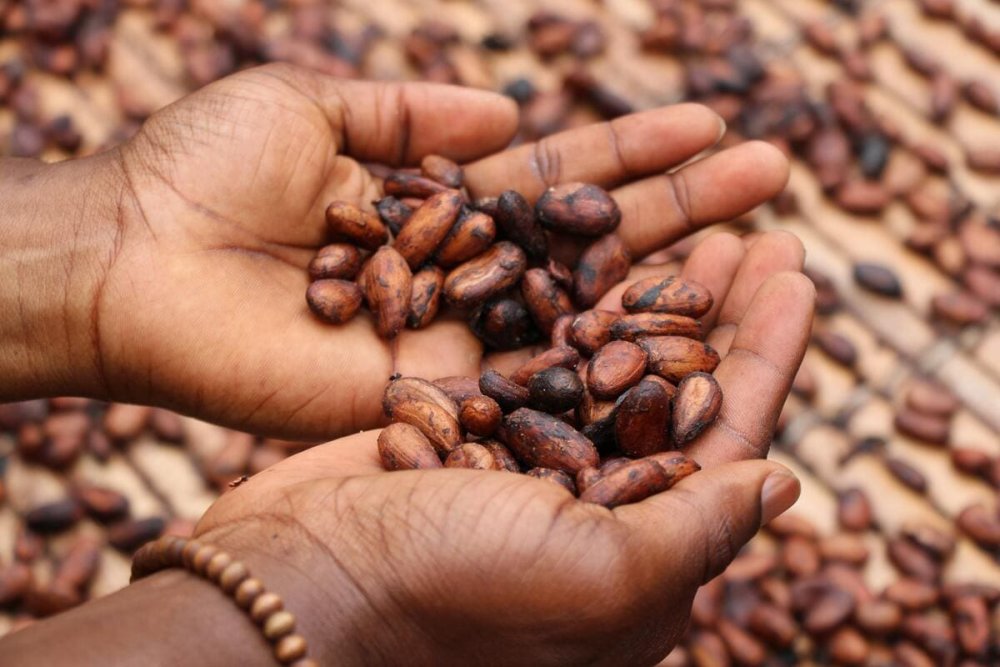The global cocoa market
Driven by global demand, the increase in areas dedicated to cocoa production has been particularly sustained since the 1970s: from 4 to more than 10 million hectares. At least half of this expansion occurred at the expense of natural forests (Kroeger et al., 2017).

Image representing cocoa.
Globally, cocoa production has grown from more than 4.4 million hectares in the early 1960s to more than 11.9 million hectares in 2022, producing more than 5.9 million tonnes of cocoa beans.
On average over the period 2012-2021, the top five producing countries (Côte d’Ivoire, Ghana, Indonesia, Nigeria, Cameroon) represent 79% of the world’s cocoa areas. Côte d’Ivoire accounts for 32% of cocoa, followed by Ghana and Indonesia. In volume terms, on average over the period 2012-2021, Côte d’Ivoire represents a production of 1.9 million tonnes, followed by Ghana and Indonesia.
The challenges of the coffee sector in France
In 2021, France is the sixth largest importer of cocoa beans in the world to manufacture a range of chocolate products for domestic consumption and export.
France imports an average of 439,000 tonnes of cocoa per year over the 2012-2021 period, and exports 253,000 tonnes.
Cocoa imported into France comes mainly from West Africa (Côte d’Ivoire, Ghana, Cameroon and Nigeria) but also frequently from European countries in which the products have transited or been processed: Netherlands (18%), Germany (15%), Belgium (6%). In France, cocoa is mainly imported in the form of: cocoa beans (21 %), cocoa paste (19 %), cocoa butter (15 %) and cocoa powder (9 %). The rest (36%) takes the form of chocolate food preparations (chocolate, sweet cocoa powder, etc.).
To produce chocolate, cocoa beans are ground into cocoa paste. Once this paste is obtained, the cocoa butter (the fat fraction) is separated from the cocoa powder (the dry fraction).
The industrial manufacture of chocolate and chocolate products therefore involves many steps from the harvest of the pods to the packaging of the finished products, involving various players from upstream to downstream of the sector. According to the Syndicat du chocolat, in 2021, the French chocolate sector represents 115 companies, 90% of which are small and medium-sized businesses. It employs more than 30,000 people, including 15,850 in industrial production.
The land footprint of cocoa
France’s cocoa imports mobilize an average of 1,456,000 hectares per year over the period 2012-2021, or 219 m2 per capita. This area has increased since 2012, with a value of 1,393,000 hectares in 2012 compared to 1,685,000 in 2021.
Sustainable cocoa
The French Sustainable Cocoa Initiative (IFCD)
The French Initiative for Sustainable Cocoa (IFCD) was launched on the occasion of World Cocoa Day 2021. It brings together the State, industrial companies, merchants, the Confédération des Chocolatiers & Confiseurs de France and the Club des chocolatiers engagés, retailers, civil society organizations, research working on the cocoa and chocolate sector in France.
The signatories of this French Initiative for Sustainable Cocoa, which concerns all cocoa and chocolate products (bars, confectionery, cocoa powder, etc.), are committed to working together to find sustainable solutions for cocoa farming in the producing regions.
Learn more: French Sustainable Cocoa Initiative (IFCD)
Certifications
Today, the two main sustainability labels used in the cocoa sector are Rainforest Alliance (from the UTZ-Rainforest Alliance merger) and the Fairtrade label. The peculiarity of the cocoa sector is that it now has an international ISO standard for sustainable and traceable cocoa, the first of its kind for agricultural products, but which is debated in West Africa where workshops are underway for the creation of a specific sub-regional standard.
In France, other fair trade labels are present on the French market such as the Fair for Life label, the Symbole producteurs paysans (SPP) or the label of the World Fair Trade Organization WFTO.
Existing certifications, however, do not yet take into account the objective of zero deforestation (CIRAD).
To find out more (reports in French):
439 000
tons
of cocoa imported by France each year
115
companies
in the production of chocolate in France
6
million
people grow cocoa worldwide

